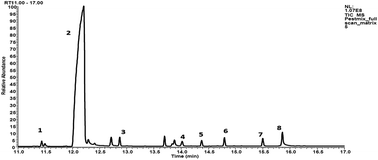Analysis of pesticide residues in tea using accelerated solvent extraction with in-cell cleanup and gas chromatography tandem mass spectrometry
Abstract
A fast, simple and easily automated method was developed for the simultaneous determination of pesticide residues in tea using accelerated solvent extraction (ASE) with in-cell cleanup and gas chromatography-tandem mass spectrometry (GC-MS/MS). This method integrates extraction and cleanup processes into a single step, by adding a clean-up sorbent along with the sample into the extraction cell. The efficiency of this method was characterized in terms of its recovery (with values ranging from 90 to 98%), repeatability along with intermediate precision (showing relative standard deviations less than 15%), and sensitivity (providing detection limits between 0.001 and 0.007 μg g−1). The concentration range of the pesticide residues found in the sample is from 0.008 to 0.161 μg g−1. The relative expanded uncertainty achieved for this method ranged from 24% to 34%. The results indicate that the proposed method is easy and reliable for the determination of pesticide residues in tea, and it is suitable for use in routine analysis.


 Please wait while we load your content...
Please wait while we load your content...